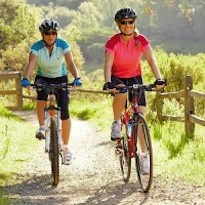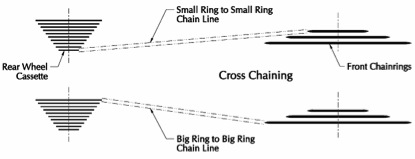NOTE: This is a repost of an article from 2013 on understanding gears on bicycles, written by Robert Baldi. It is very helpful for those just transitioning to outdoor riding from indoor cycling classes or for instructors who like to inspire students to also ride outside. But after many years of working with cyclists, I realize that even some people who have been riding recreationally for a long time might still not understand some aspects of gearing.
I was reminded of that this past weekend riding with a group of friends. We were on a flat road and the derailleur of one of the riders was making noise and we couldn’t figure out why. As I rode next to her I looked down and said, “Oh, it’s because you’re cross-chaining,” but she had no idea what I was talking about. Translation: She was in her smallest size (inside) ring in front, and smallest size—but higher gear—(outside) ring in back, essentially forcing the chain to “cross” at the sharpest angle, from inside to outside. The chain is at its loosest (in the two smallest size rings), and the extreme angle causes the chain to rub on the derailleur. It is not an ineffective gear to be in and is easily remedied by shifting to the larger ring in front and then shifting to an easier gear in back. She didn’t know to avoid this gear combination, but we had just climbed a very hard 5-mile steep mountain, so she certainly is a fit rider who has been cycling for years.
That incident reminded me that it might be helpful to post this article by Robert again. Also, I found an article by Bicycling magazine called How to Shift a Bicycle: Beginner’s Guide. Share it with your newer cyclists, and enjoy!
Now here is Robert’s article on gearing:
So you want ride a bike outside? Good for you! While I am sure that you’re more than fit enough for it, there are a few things you may find useful to know and the first of these is gears, unless you plan to ride a fixed-gear bike.
If you’ve ridden indoors, you will either have used a knob or a lever to adjust the resistance and change the intensity of the effort or simulate a change of terrain. In real life, gears are utilised for the opposite effect, namely to make life easier for yourself and help you ride at your preferred cadence, whatever the terrain. For example, most experienced cyclists will prefer a narrow cadence range of 85–95 rpm, i.e., what we’d call a flat road in indoor cycling.
To travel at a set speed, using a lower gear will mean less force but require the rider to pedal at a faster cadence. Likewise, a higher gear means a slower cadence but greater force is required. Research has shown that pushing too high a gear at low cadences is inefficient, so when you start going uphill, rather than trying to grind your way up at 40 rpm, you’ll change down a few gears in order to maintain a faster cadence. Likewise, cadences above 100 rpm are less effective after short bursts such as sprints, so you’d want to shift up a gear or two to maintain your efficiency.
Modern gearing consists of small sprockets on the back and bigger ones at the front attached to the pedals, known as chainrings. Each of these will be referred to by the number of teeth, usually something like 12–27 at the back and 53–39 at the front. You may have a triple chainring, especially on a mountain bike, for a greater range of gears, and anywhere up to eleven at the back. I’ll get into the combinations later but the takeaway factoid for now is that moving to a smaller sprocket at the back means you’ve shifted up a gear, but shifting to the smaller chainring means you’ve moved to an easier set of gears. Yes, I know…but you’ll get used to it!
Changing gears is by means of front and rear derailleurs, from the French word for derailing trains from one track to the next. They are operated remotely by a cable attached to a shifter, usually a lever, which changes the cable’s tension and moves the chain guide sideways, thus derailing the chain. While the front derailleur only has to move the chain side to side between the two (or three) front chainrings, the rear derailleur also takes up any slack in the chain when you move to a smaller sprocket at the back and/or a smaller chainring.
So far, so good. If you had only a single chainring, you’d just shift the chain up and down the sprockets and you’d know where you were. The question I get asked most often is: “So when do I change chainrings?” The answer is more easily shown than explained, so we’ll now discuss gear ratios. What does each combination, front and back, mean in terms of effort and distance? There are different ways of measuring gear ratios:
- Front/Rear: This was my notation above, which only considers the sizes of the chainrings and rear sprockets. It doesn’t consider the size of the wheels nor the length of your crank arms, which are essential variables in knowing how far you travel in a single pedal stroke.
- Gear Inches: This harks back to the Victorian era and penny-farthings. Where the pedals were directly attached to the wheel, the diameter in inches of the driven wheel was an indication of speed, so that a 60-inch wheel travelled farther than a 50-inch wheel for each pedal stroke.
- Metres of Development: The modern-day equivalent of gear inches, it measures the distance travelled with each turn of the pedals, calculated as circumference of drive wheel in metres multiplied by the number of teeth on chainring and divided by the number of teeth on rear sprocket.
- Gain Ratio: This goes further still by taking the length of the pedal crank arm into account. Most indoor and track bikes will have a short crank length of 170mm; most outdoor bikes come fitted with 172.5mm cranks, but longer-legged riders will want to take advantage of their greater leverage by going up to 175mm or higher.
I, and many in the cycling world, will exclusively use the first method as road bikes will predominantly have standard-sized wheels, referred to as 700c. You will usually see this combined with the tire width, e,g., 700×23 or 700×25. However, to better understand gear ratios, it is best to use the latter method and include all variables.
Here is a gear chart using gain ratios for a 700×23 tire and with 172.5mm cranks. I’ve used a standard race-spec 10-speed cassette of sprockets, as they are fairly close-geared: 11-12-13-14-15-16-17-18-19-21. The chainrings are 53 and 39 teeth. Have a look and I’ll expand below:
| 53 | 39 | |
| 11 | 9.3 | 6.9 |
| 12 | 8.5 | 6.3 |
| 13 | 7.9 | 5.8 |
| 14 | 7.3 | 5.4 |
| 15 | 6.8 | 5.0 |
| 16 | 6.4 | 4.7 |
| 17 | 6.0 | 4.4 |
| 18 | 5.7 | 4.2 |
| 19 | 5.4 | 4.0 |
| 21 | 4.9 | 3.6 |
See the pattern? The 53-chainring scale is four steps “ahead” of the 39 scale, so that a 53×15 has almost the same gain ratio as a 39×11. So what? Well, when the chain is moved sideways, the links are no longer in a straight alignment and this increases friction and wastes precious energy. Having your chain in a large chainring/large sprocket or a small chainring/small sprocket combination is an extreme you want to avoid. You may even hear the chain rub against the chainring and sprockets or the derailleur. This is known as cross-chaining, and is evident in this image (note this image depicts a triple chainring in front):
When you think about it, it does make sense—if you’re in a large chainring, you want to push a big gear; so why be on a large sprocket (small gear)? Likewise, if you want a small gear and you’re on the small chainring, why then shove the chain into your smallest sprocket? Another reason you don’t want this extreme combination is that when the chain is in a big/big combination, it is stretched to its maximum and can stress the chain so that it wears out more easily. In a small/small combination, the chain is in its most relaxed state and is much more likely to fall off.
Imagine a flat road gradually rising to a climb. What gear should you be in? For your full range of gears, I would suggest a good option is starting on a 53 chainring, to shift down one sprocket at a time until you reach your 53×17. Now is a good time to change to the 39 (smaller) chainring AND shift down three times to your 14 sprocket. Then you can keep changing down until you reach 39×21, your bottom gear. I have highlighted the gain ratios in the table above to illustrate this concept.
I wouldn’t get too worried about the numbers, however, just be aware that there will be a good window of opportunity for you to change chainrings and a few sprockets with minimal fuss. Don’t wait until you reach an extreme point; trying to change when on a 53×21 may even make your chain come off, such is the strain on it.
For the data geeks among you, I recommend using the Sheldon Brown Gear Calculator. It will allow you a multitude of combinations to find the gain ratios of any groupset (the combination of cranks, chainrings, and sprockets).
[box] Robert Baldi is a Star 3 Spinning® instructor and coach in the UK, and has contributed some exciting profiles for ICA, including Top Gun and several Tour de France profiles (part of the TDF package). He is an active cyclist and has ridden many of the big climbs of the Tour de France. He loves nothing more than introducing newbies to the wonderful world of cycling![/box]



